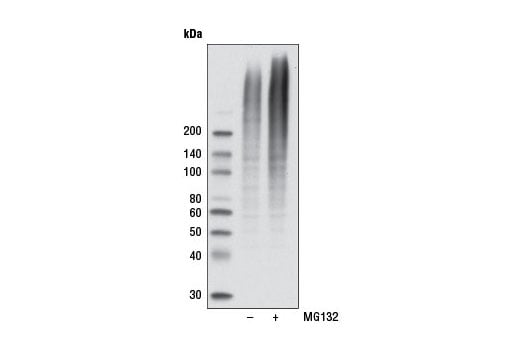 全部商品分类
全部商品分类



Monoclonal antibody is produced by immunizing animals with a synthetic peptide corresponding to residues surrounding the Lys48 branch of the human diubiquitin chain.


Product Usage Information
| Application | Dilution |
|---|---|
| Western Blotting | 1:1000 |



Specificity/Sensitivity
Species Reactivity:
All Species Expected




Supplied in 10 mM sodium HEPES (pH 7.5), 150 mM NaCl, 100 µg/ml BSA, 50% glycerol and less than 0.02% sodium azide. Store at –20°C. Do not aliquot the antibody.
参考图片
Western blot analysis of H1703 cells, untreated or treated with MG132 as indicated, using K48-linkage Specific Polyubiquitin (D9D5) Rabbit mAb.
Western blot analysis of recombinant monoubiquitin (MonoUb), linear unbranched ubiquitin chain (Ub2-7), K48-linked polyubiquitin (K48-Ub2-7) and K63-linked polyubiquitin (K63-Ub2-7), using K48-linkage Specific Polyubiquitin (D9D5) Rabbit mAb (upper) and Ubiquitin (P4D1) Mouse mAb #3936 (lower). Ubiquitin chains range from 2 to 7 in length.
Western blot analysis of six distinct recombinant polyubiquitin chains using K48-linkage Specific Polyubiquitin (D9D5) Rabbit mAb (upper) and Ubiquitin (P4D1) Mouse mAb #3936 (lower).






 用小程序,查商品更便捷
用小程序,查商品更便捷




